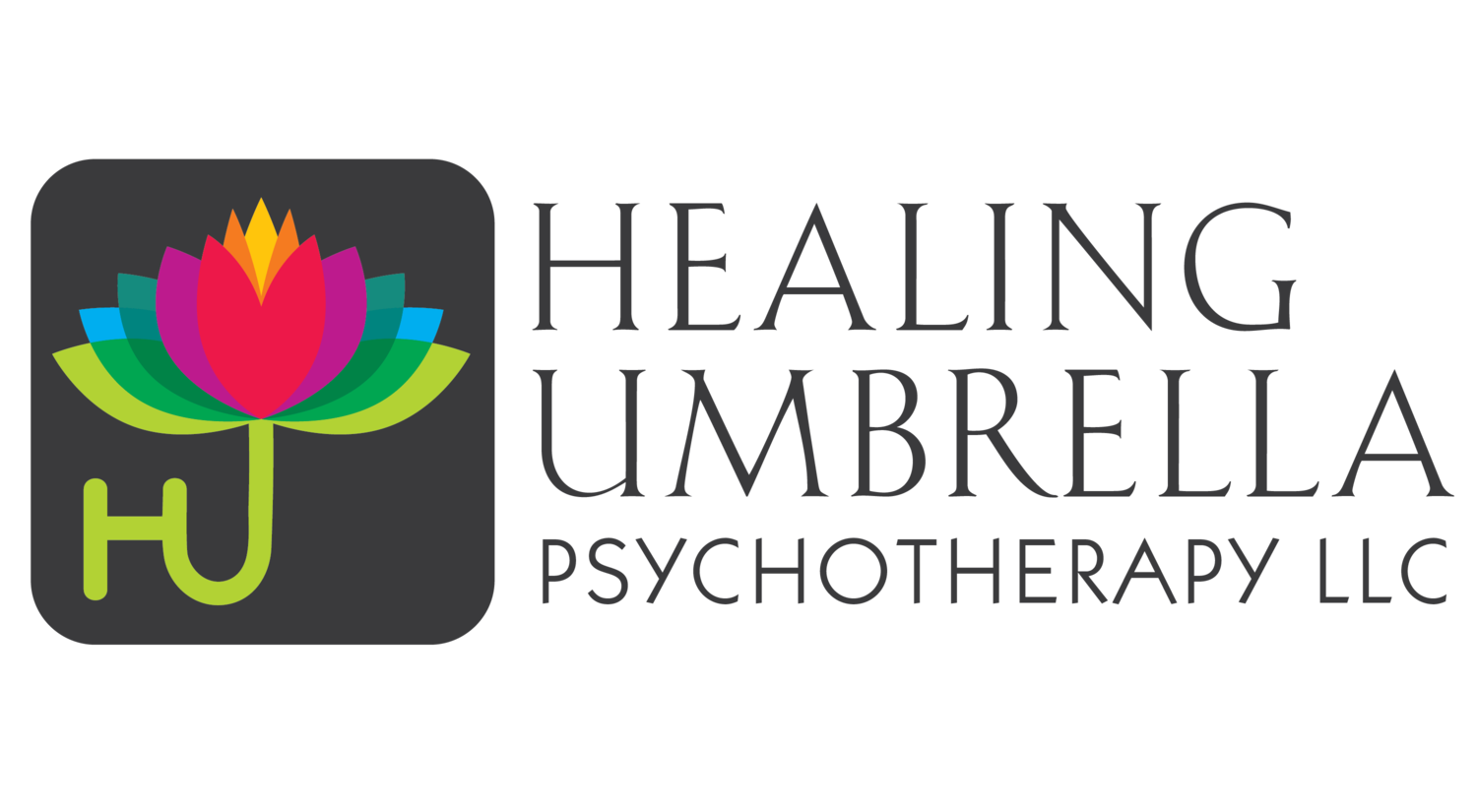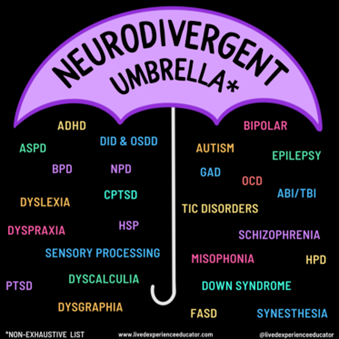What is the Neurodiversity Umbrella?
by Nat Nigro, M. Ed., NCC (they/them)
Nat is a neurodivergent Nashville-based therapist specializing in neurodivergent-affirming therapy at Healing Umbrella Psychotherapy
You may be hearing the terms “neurodiversity” or “neurodivergent” more recently. Many mistake neurodivergent to be synonymous with someone who is autistic or has ADHD, or both. However, neurodivergent and neurodiversity are concepts from the neurodiversity movement which are much larger than that.
Terminology
Neurodivergent is a neutral term that refers to an individual whose brain diverges from the norm or what is expected from society in terms of neurological functioning. This is an umbrella term, meaning it encompasses many different identities or neurotypes.
These can include autism, epilepsy, OCD, personality disorders, plurality (DID, OSDD, or other systems), dyslexia, etc. It is intentionally a broad and non-exclusionary term. Some neurodivergence is innate, like autism or ADHD or FASD, because people are born with those neurotypes.
Neurodivergence can also be acquired, like DID, PTSD, or TBI. And as we know, biology is complex and cannot be grouped into discrete categories (as much as we like to attempt to do so), therefore, neurodivergence can be a mix of genetic and environmental influences.
Neurotypical refers to someone whose brain functions within society’s standards and does not diverge significantly from the norm. It is the inverse of neurodivergent.
Neurodiversity is a term that was coined in 1998 by Judy Singer, an Australian sociologist, to refer to the natural human diversity of minds. The concept surrounding neurodiversity has existed far before that date, however, Singer was the first person recognized to bring it into the academic sphere. It is important to note that Singer has since publicly engaged in harmful discourse supporting transphobic and racist beliefs which is fundamentally antithetical to the Neurodiversity paradigm.
Luckily, there are many great resources that are rooted in an intersectional and anti-oppressive approach to education and advocacy (some of which I will list at the bottom of this article!). The concept of neurodiversity recognizes that diversity is a normal and expected part of the human experience, and extends this to how we conceptualize the diverse way in which humans function, think, feel, and act.
Neurodiverse is an adjective which describes a group of people with different brains. This group can include neurotypical and neurodivergent people.
The Neurodiversity Movement
The Neurodiversity movement is a social, political, and human rights movement that is in opposition to neuronormativity. It supports the fact that neurological diversity is an important facet of human diversity, and that diversity in functioning and thinking is not problematic or wrong. If our worth and humanity is not dependent on productivity, then our way of functioning and ability to function within the constraints of society cannot be deficits.
The movement was born from the 1970s disability rights movement where people started moving away from the medical model of disability as the only way to view the diversity of human minds and bodies. The concept of neurodiversity became a more recognized term after Judy Singer included it in her thesis in 1998.
At its origin, the movement began with the discussion of neurodiversity in the first autistic led online community, then united autistic people with ADHDers, and those with learning disabilities; it has since expanded to advocate beyond these initial groups who found belonging in the movement to include advocacy for anyone who feels their brain diverges from what society asserts as the norm.
The Neurodiversity Umbrella in the Mental Health Field
The mental health field historically operates from a medical model in which the DSM (in the U.S.) is used to define what is healthy and what is unhealthy. Our current system of diagnosis rests on a paradigm of deficits to be fixed, and while it can be helpful in some ways (for example, getting accommodations in work or school, or sometimes gaining access to resources), it also can be harmful (for example, a diagnosis can be used to discriminate against people, especially those with other marginalized identities).
Science is ultimately a continuous cycle of guessing and checking, making adjustments that better explain new data and insight we gain. While the DSM is typically viewed as definitive, it is the result of the application of the scientific method in the field of psychiatry and psychology; it is very possible for people to otherwise resonate with an experience even if they do not happen to meet all of the specific criteria for a specific condition.
The DSM is the most current version of an attempt to categorize and name various observable patterns of human behavior and experiences that tend to occur together, but by no means does it fully capture the nuance and complexity of every human's experience (nor could it).
In the context of the mental health field, the Neurodiversity movement supports a complete paradigm shift which rejects neuronormativity and depathologizes the way brains differ. The spread of information around Neurodivergence serves to return power and autonomy back to individuals rather than upholding systems of gatekeeping where the provider is seen as the expert of their clients’ experiences.
The Neurodiversity paradigm makes space for people to understand themselves better, self-advocate for their wants and needs, and foster a more individualized approach for healing based on what is important to each person.
An understanding and awareness of the Neurodiversity Paradigm and Neurodiversity-affirming principles within counseling can significantly impact what therapy may look like for Neurodivergent individuals. For example, providers operating from the medical model in which plurality is seen as a disorder often assert that the goal for DID or OSDD systems in therapy is integration because of neuronormative standards and the assumed goal of decreased pathology according to the DSM. However, the goal for each client may differ, and many systems may want to work towards functional multiplicity by establishing an internal sense of safety and fostering more effective communication between parts.
Additionally, people with OCD may be told that ERP (Exposure and Response Prevention) is the “gold standard” and that they need to do ERP if they want to feel better. However, this approach does not take into consideration the ways in which the process of habituation differs for different people (e.g. autistic brains do not habituate to stimuli in the same way allistic brains do), or the fact that their clients may want to approach their OCD in a different way depending on how it impacts them and that there are multiple ways to approach OCD (e.g. using psychoeducation, ACT, I-CBT, accommodations, or a combination of these).
Ultimately, clients should be given a full picture of their options so they can autonomously choose what is best for them (i.e. informed consent), because the fact that a therapist has certain education and training does not mean they know what a client needs in their unique situation and our clients deserve a nuanced and personalized approach to their care.
These are just two examples of how awareness of the Neurodiversity Paradigm can alter what therapy might look like for Neurodivergent people, but there are many more examples for other neurotypes and situations.
Why is Neurodivergent as an Identity Beneficial?
Humans are meant to be in connection with each other and inherently want to feel a sense of belonging. Having a way to categorize and name our experiences is helpful in facilitating that so that we can communicate with shared language to better understand each other.
The concept of neurodivergence acknowledges the complexity of human minds and helps serve to bring more fluidity and flexibility to what is currently a rigid and exclusionary diagnostic system with stagnant criteria. There is an inherent sense of liberation in the broadness of the term neurodivergent.
Neurodivergence as an identity also provides language to foster community both online and in person to help people learn from those with shared experiences the ways in which they are not alone and are not broken. Community and connection also provide space for sharing of resources and supports from a place of lived experience, so that neurodivergent people can expand how they support themselves and get their needs met.
Therapy can be a healing space for connection, but community provides the structure for lasting connection and belonging outside of the therapeutic relationship.
Resources
As a fundamental principle of the neurodiversity movement, prioritizing the voices of those with lived experience is important to consider when seeking out information. There is a wealth of knowledge that is only growing as self advocates continue to provide education and labor in support of the neurodiversity movement.
Below are some great sources that I would recommend as a starting place. However, if you want to expand your knowledge and understanding of neurodiversity, I would encourage you to search beyond these sources to find sources of information with varied identities and experiences, especially those different from your own.
And to the extent you are able, financially or otherwise, supporting the educators and advocates as you benefit from their labor, as their perspective from a place of personal experience is invaluable.
Neurodiversity - general
Sonny Jane Wise
Website - https://www.livedexperienceeducator.com/
Instagram - https://www.instagram.com/livedexperienceeducator/?hl=en
DBT Workbook - https://www.livedexperienceeducator.com/store/p/neurodivergent-friendly-workbook-of-dbt-skills
Were All Neurodiverse - https://www.thriftbooks.com/w/were-all-neurodiverse-how-to-build-a-neurodiversity-affirming-future-and-challenge-neuronormativity/38369635/#edition=66305258&idiq=55842052
Dr. Neff
Website - https://neurodivergentinsights.com/
Instagram - https://www.instagram.com/neurodivergent_insights/
Neuroabolition - https://www.instagram.com/neuroabolition/
Intersectional Disability justice
Imani Barbarin
Psychosis/schizophrenia/reality orientation differences
Rose Parker
Website + blog - https://www.psychosispsositivity.com/
Instagram - https://www.instagram.com/psychosispsositivity/
Autism
Embrace autism website - https://embrace-autism.com/
Neurowild - https://www.instagram.com/neurowild_/?hl=en
Sandra Coral - https://www.instagram.com/nd.narratives/
AAC (Augmentative and Alternative Communication)
Tiffany Hammond - https://www.instagram.com/fidgets.and.fries/
ARFID
Lauren Sharifi
Instagram - https://www.instagram.com/arfid.dietitian/
Resources - https://laurensharifi.com/arfid-nutriton-resources/
Kevin: Instagram - https://www.instagram.com/kevindoesarfid/
ED/fat liberation
Stacie Fanelli: https://www.instagram.com/edadhd_therapist/?hl=en
Sonalee: https://www.instagram.com/thefatsextherapist/?hl=en
Nic McDermid
Website - https://www.nicmcdermid.com/
Instagram - https://www.instagram.com/nic.mcdermid/?hl=en
Lindley Ashline
Website - https://bodyliberationphotos.com/links/
Instagram - https://bodyliberationphotos.com/links
Personality disorders
Systems/Plurality
The Plural Association
Website - https://thepluralassociation.org/
Instagram - https://www.instagram.com/thepluralassociation/
Gianu system - https://www.instagram.com/gianusystem/?hl=en

